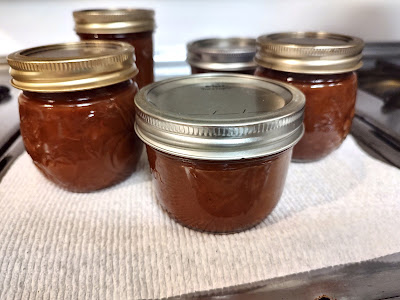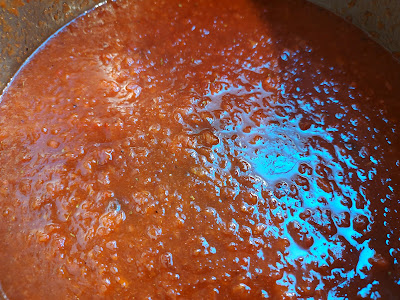
Recipe: P.A.T. Chutney combines plums (or pluots), apricots and tomatoes

|
Summer brings a mixed bag of fruit as plums, apricots and pluots pile up in my refrigerator drawer. Meanwhile, tomatoes are taking over the counter space.
This easy chutney makes use of them all in a sweet-savory combination. I call it P.A.T. – plum-apricot-tomato – but pluots (which are a cross of plums and apricots) work, too.
No peeling necessary. Roughly chop the fruit and let it cook down slowly. The longer it simmers, the thicker it becomes.
P.A.T. Chutney
Makes 6 cups or half-pint jars
Ingredients:
4 tablespoons butter or margarine
2 cups onions, finely chopped
1 cup chicken or vegetable broth
¼ cup red wine
¼ cup fig balsamic vinegar
½ cup sugar
4 pounds plums, pluots and/or apricots, pitted and roughly chopped
1 pound tomatoes, hulled and roughly chopped
1 cup raisins
1 teaspoon lemon black pepper
1 teaspoon salt
1 teaspoon paprika

|
Instructions:
In a large, heavy pot, melt butter or margarine. Sauté chopped onions until soft.
Add broth, wine, balsamic vinegar and sugar. Bring to a boil.
Add fruit and tomatoes. Return to boil, then reduce to simmer and cover.
After tomatoes and fruit start to break down, remove cover and add raisins.
Simmer uncovered, stirring often, until chutney is desired thickness. For thick, jamlike consistency, simmer chutney at least 1 hour, stirring often to prevent scorching.
Add pepper, salt and paprika. Adjust seasoning.
Refrigerate or freeze in half-pint containers. This chutney will keep at least a month in a covered jar in the refrigerator.
Or process jars 10 minutes in a hot-water bath.
Comments
0 comments have been posted.Sacramento Digs Gardening to your inbox.
Sites We Like
Garden Checklist for week of July 21
Your garden needs you!
* Keep your vegetable garden watered, mulched and weeded. Water before 8 a.m. to reduce the chance of fungal infection and to conserve moisture.
* Feed vegetable plants bone meal, rock phosphate or other fertilizers high in phosphate to stimulate more blooms and fruiting. (But wait until daily high temperatures drop out of the 100s.)
* Don’t let tomatoes wilt or dry out completely. Give tomatoes a deep watering two to three times a week.
* Harvest vegetables promptly to encourage plants to produce more. Squash especially tends to grow rapidly in hot weather. Keep an eye on zucchini.
* Pinch back chrysanthemums for bushy plants and more flowers in September.
* Remove spent flowers from roses, daylilies and other bloomers as they finish flowering.
* Pinch off blooms from basil so the plant will grow more leaves.
* Cut back lavender after flowering to promote a second bloom.
* It's not too late to add a splash of color. Plant petunias, snapdragons, zinnias and marigolds.
* From seed, plant corn, pumpkins, radishes, winter squash and sunflowers.